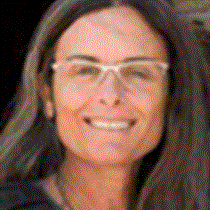Isla San Esteban, Isla San Pedro Martir & At Sea
Today was a perfect example of why Baja California is such an amazing place to travel.
We awoke pulling in to our anchorage at Isla San Esteban, a beautiful sunrise sky to starboard, a stunning desert arroyo and geologic formations to port. After breakfast we set out to shore to explore the arroyo, and to search for the endemic large pinto chuckwalla lizards and spiny-tailed iguanas who make San Esteban their home. We wandered this lovely desert arroyo, enjoying the birds, plants, and many lizards and iguanas we found there.
We returned to the ship to begin our course south towards Isla San Pedro Martir. In no time flat we found ourselves watching fin (finback) whales. As we continued on our approach to San Pedro Martir, we saw huge numbers of birds flying to and from the island, and occasional feeding frenzies on the surface. Distant blows could be seen, and more fin whales surfaced near the ship.
As we rounded the island to get to the leeward side, there was a constant parade of mostly young brown boobies flying up the side of the ship, all the way to the bow, only an arm’s reach away, curiously observing the guests lining the bow railing. It was fun to watch them, and even funnier to see how their feet would drop down as air brakes to slow them down. Red-billed tropicbirds screamed by overhead, while adult brown and blue-footed boobies, and brown pelicans filled the sky above, all moving around this guano covered bird nesting island. The barking of sea lions reverberated along the steep rock walls.
Once again we resumed our southerly voyage, but again, we didn’t make it far before the low, angular blows of sperm whales interrupted Pete Pedersen’s talk on “The Moustached Whales.” We’d found a nursery group of female sperm whales with their young. They were very close to the ship and our Captain navigated the ship expertly for even better views. A large male suddenly appeared with the group and his massive size was a great sight to see in contrast to the females and younger whales. This group of seven animals gave us a terrific sight as they fluked one right after another, disappearing elegantly under the water.
We encountered more sperm whales, and then, a group of long-beaked common dolphin appeared surfacing right next to the boat, bow-riding. Moments later, Ged Caddick announced another exciting sighting on the bow — Issac (our bartender) was arriving with margaritas and Mexican beers on the bow.
As the sun was getting low in the sky, when we couldn’t imagine things getting any better, suddenly a group of bottlenose dolphins came in to bow-ride the ship. The entire bow was lined with people leaning far over the rail watching, squealing with delight.
What a day! Once again, we resumed our southerly course, headed for the mid-drift islands and the Bahia de Loreto National Park.
Today was a perfect example of why Baja California is such an amazing place to travel.
We awoke pulling in to our anchorage at Isla San Esteban, a beautiful sunrise sky to starboard, a stunning desert arroyo and geologic formations to port. After breakfast we set out to shore to explore the arroyo, and to search for the endemic large pinto chuckwalla lizards and spiny-tailed iguanas who make San Esteban their home. We wandered this lovely desert arroyo, enjoying the birds, plants, and many lizards and iguanas we found there.
We returned to the ship to begin our course south towards Isla San Pedro Martir. In no time flat we found ourselves watching fin (finback) whales. As we continued on our approach to San Pedro Martir, we saw huge numbers of birds flying to and from the island, and occasional feeding frenzies on the surface. Distant blows could be seen, and more fin whales surfaced near the ship.
As we rounded the island to get to the leeward side, there was a constant parade of mostly young brown boobies flying up the side of the ship, all the way to the bow, only an arm’s reach away, curiously observing the guests lining the bow railing. It was fun to watch them, and even funnier to see how their feet would drop down as air brakes to slow them down. Red-billed tropicbirds screamed by overhead, while adult brown and blue-footed boobies, and brown pelicans filled the sky above, all moving around this guano covered bird nesting island. The barking of sea lions reverberated along the steep rock walls.
Once again we resumed our southerly voyage, but again, we didn’t make it far before the low, angular blows of sperm whales interrupted Pete Pedersen’s talk on “The Moustached Whales.” We’d found a nursery group of female sperm whales with their young. They were very close to the ship and our Captain navigated the ship expertly for even better views. A large male suddenly appeared with the group and his massive size was a great sight to see in contrast to the females and younger whales. This group of seven animals gave us a terrific sight as they fluked one right after another, disappearing elegantly under the water.
We encountered more sperm whales, and then, a group of long-beaked common dolphin appeared surfacing right next to the boat, bow-riding. Moments later, Ged Caddick announced another exciting sighting on the bow — Issac (our bartender) was arriving with margaritas and Mexican beers on the bow.
As the sun was getting low in the sky, when we couldn’t imagine things getting any better, suddenly a group of bottlenose dolphins came in to bow-ride the ship. The entire bow was lined with people leaning far over the rail watching, squealing with delight.
What a day! Once again, we resumed our southerly course, headed for the mid-drift islands and the Bahia de Loreto National Park.




